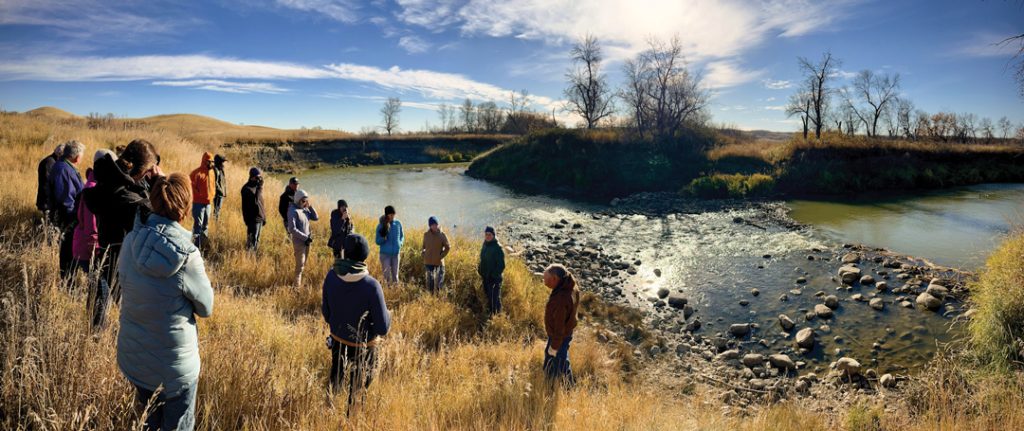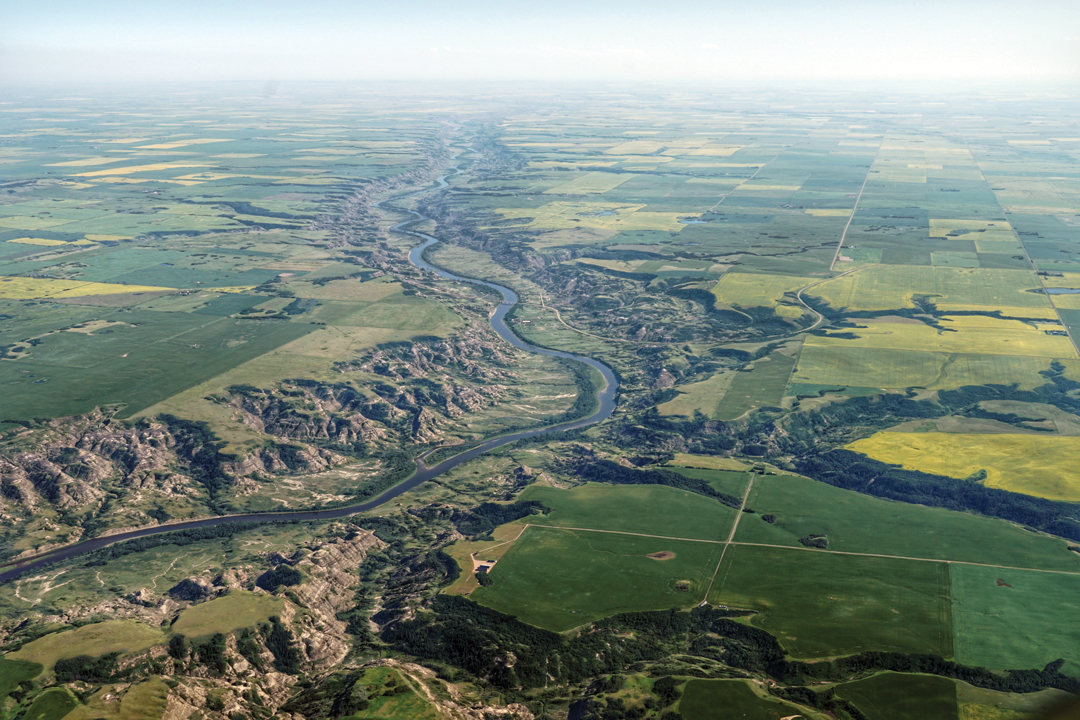FOR SERVICES RENDERED
BY MADELEINE BAERG • LEAD PHOTO: PIXABAY
For generations, Canadian farmers have been careful stewards of the grasslands, watersheds and cropland their livelihoods depend upon. It is only recently, however, they have begun to receive wider public recognition and financial compensation for the critical environmental benefits their practices deliver.
ALUS (previously Alternative Land Use Services but now known exclusively by its acronym) is a national charitable organization created by farmers, for farmers. It provides cash payments for ecosystem services. The term “ecosystem services” describes certain intentional management practices that deliver public good. Such environmental benefits include carbon capture, water filtration, preservation of wildlife habitat and support of biodiversity.
ALUS projects include creek corridor restoration; enhancement of water bodies, riparian zones and forested watershed areas, as well as the use of sustainability-focused practices to boost agricultural profitability in saline soil. In addition, ALUS conducts regenerative ag and enhanced grazing pilot studies. Most, though not all, projects focus on “additionality,” or changes that improve the environment.”
“The world is beginning to see the role of farmers as much more expansive than has ever been considered before. There is a marketplace emerging for ecosystem services, and ALUS is a vector from that marketplace to the farm gate,” said Bryan Gilvesy, the organization’s CEO. “ALUS is leading the charge into that space, showing that, yes, farmers can produce food, fibre, fuel and ecosystem services from their lands.”
Launched in Manitoba in 2006 by a group of agricultural and environmental groups, ALUS now serves 35 communities in six provinces. Since its inception, ALUS has helped more than 1,400 Canadian farmers gain some credit and dollars for their environmental contributions. The organization intends to eventually expand nationwide.
“ALUS depends on grassroots energy to bring us to new places. We wait for the community to approach us. We think that’s the right way to grow,” said Gilvesy. Farmers and communities are lined up to join the program, he added.
Gilvesy has personal experience with the benefits ALUS provides farmers. He and his family run a Texas longhorn cow-calf operation in southern Ontario. In 2006, they were among the first farmers to partner with ALUS on a grassland restoration project. He joined the program for the same reason any Canadian farmer might. “It values me and my family’s work. It values our contributions. It helps me understand a world I didn’t know but am eager to participate in.”
That same year, he became chair of his local ALUS partnership advisory committee (PAC). ALUS programs are governed by these committees in each jurisdiction the organization serves. Established on a pilot basis under the Delta Waterfowl Foundation in 2006, the local PAC was made permanent in 2008 and served as a template for the growth of ALUS across Canada. Nine years later, when ALUS became an independent national charitable organization, Gilvesy became CEO.
SENSIBLE ECONOMICS
Ryan Hering farms grain and oilseeds near Bruno in central Saskatchewan. In 2016, he contacted ALUS hoping to find a way to generate benefit from 100 non-productive acres. “I read about ALUS and thought that sounded attractive. I had some saline soils that weren’t producing where I was fighting with weeds and wasting inputs, which wasn’t good for me or the environment. ALUS had some funding, so I put in an application, got approved and we seeded the land to perennial grasses.”
He was so pleased with the multiple environmental benefits of the project, he and ALUS launched a second 45-acre project on his land in 2019. “I was losing money on those acres before and now I’m making a little bit, so it’s a big benefit to me. It just economically makes sense.
“There’s groundcover now, so it’s helping with the saline situation,” he added. “The salts aren’t evaporating to the soil surface as badly as they were. There’s less erosion because there’s no bare soil. It’s producing less weeds that spread around the countryside when the winds blow. And there are some wildlife benefits. I’m seeing more rabbits, waterfowl and deer.”
Seventeen communities and 400 farmers are now active in the program in Alberta, which counts more than 21,000 acres of marginal land in the province protected or enhanced as grassland, wetland and woodland. In total, across Canada, 1,421 ranchers and farmers and 35 communities participate in ALUS projects that total almost 38,000 acres.
Current Alberta projects include creek corridor restoration in the County of Barrhead, enhancement of water bodies, riparian areas and forest in the Sylvan Lake watershed as well as establishment of riparian pasture, alternative livestock watering systems and conservation and restoration of native plant and animal species in the Municipal District of Pincher Creek.
ALUS operates according to the priorities and perspectives of farmers. “Our number 1 message is we are a farmer’s conservation plan. We protect farmers’ privacy and their data. We try to maximize farm gate receipts and minimize the amount of work farmers have to do to participate in our programs. And we offer a supportive community for farmers who enter this space. It’s as farmer friendly as you can get,” said Gilvesy.
As such, the organization operates differently than other marketplaces for environmental goods and services. Contracts are written in five-year periods with a renewal option rather than in perpetuity.
As well, farmers themselves administer the program locally. At least half the members of each ALUS PAC must be farmers. These committees determine payment rates, which are usually anywhere from $20 to $220 per acre, and program details based on local land values and environmental priorities and manage projects with support from ALUS staff.
“If ALUS is a machine for creating change on the agricultural landscape, the PAC is sitting in the driver’s seat and the farmer participants are the fuel that makes it possible,” said Paige Englot, ALUS senior hub manager for the Prairies.
“The PACs are absolutely core to delivering our projects,” said Gilvesy. “We follow the same principles and deliver the same programs in every area, but every agricultural setting is different. The PACs address all those differences and provide the right programming for each individual community.”
Rather than an incentive- or subsidy-based model, ALUS uses fee-for-service. It pays farmers for the ecosystem services they produce just as if they had produced an agricultural commodity. Funding streams include startup cash for upgrades such as exclusion fences, off-site water, feed material for native planting, dirt work for wetland restoration and other infrastructure. While project costs are usually shared between ALUS and the landowner, the organization may entirely finance projects of particularly high ecological value. Land taken out of agricultural production typically captures a higher payment rate than marginal terrain, wetlands or riparian areas.
“ALUS is not looking to compete with agriculture,” said Englot. “In order for a project to be successful, it needs to fit the individual farming operation. Projects often take place in marginal rather than highly productive spaces, or in areas that are difficult to navigate with large farm equipment. We encourage farmers to look at ecosystem services as something with economic value: a financial reward for services that coexist with agriculture.”
Rather than operating as a stand-alone, ALUS works to integrate its projects with those of its partners, said Englot. “We’re offering another tool in the toolbox; a grassroots option to help address environmental targets, but that works in conjunction with existing policy, with federal, provincial and local programs and with other groups.”

THE ENVIRONMENTAL SERVICES MARKETPLACE
The environmental goods and services marketplace is comprised of sellers—farmers, in this case—and buyers. In its fifth year, the ALUS New Acre Project allows corporations to offset landscape impacts with the purchase of environmental goods and services outcomes by the acre.
“New Acre Project is the vehicle we use to achieve the selling of the environmental goods and services product,” said Gilvesy. Corporate interest continues to grow, driven by demand from investors and customers, he added.
“Several corporations have come in the door because New Acre Project is delivered by farmers in their communities, it offers real outcomes and it rewards farmers for the production of all ecosystem services, not just carbon sequestration. It becomes a uniquely powerful tool for corporations that want to do more than just offset their carbon footprint.”
Cargill, A&W, General Mills and Danone have announced New Acre projects. In fall of 2022, ALUS also rolled out a similar program targeted to small through medium-sized businesses looking to offset their environmental footprints.
While corporate commitment is important, ALUS derives funding from multiple sources. In the spring of 2022, Sustainable Development Technology Canada (SDTC) committed $5 million to the organization for its continued growth as well as to build capacity to quantify and validate its work. SDTC’s mission is to fund and foster Canadian companies that develop and commercialize new Canadian technologies with the potential to create environment benefits and economic prosperity. The SDTC endorses the importance of farmer-led environmental solutions, said Gilvesy. “We believe their due diligence process has indicated, yes, ALUS can provide these sorts of solutions for Canadians.”
Most of all, he added, ALUS recognizes the value of farmer-led ecological stewardship. “For years on the farm we felt not included in conversations about land stewardship and the environment. Rather, we felt that people were talking down to us. This is farmers like me standing up and saying, ‘We’ve got something to offer, and we can make a difference.’”







Comments